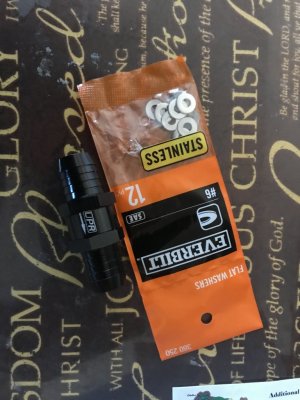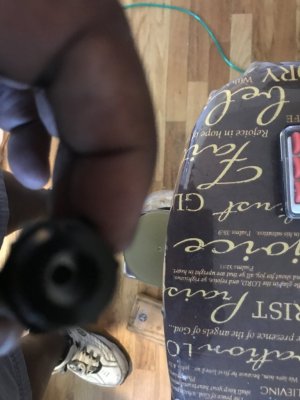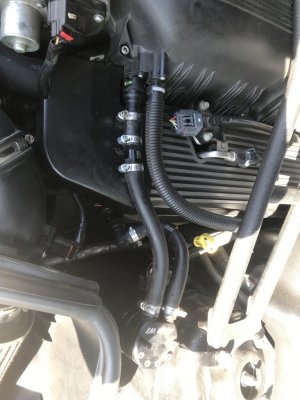GlassTop09
Senior Member
The problem Midlife Crises is describing is when the engine is coming from higher RPM's when the throttle body plates are fully closed (deceleration). The PCV valve located inside the driver side valve cover is a plunger w\ a specific sized orifice drilled in it's seat that is metering the amount of air to allow thru the PCV valve when the intake goes into high vacuum & the PCV plunger is drawn onto it's seat to "restrict" this airflow thru the crankcase. This amount of airflow will change due to the amount of deltaP (pressure drop) across the PCV orifice so the PCM will be trying to compensate for the rest of the airflow trying to control the engine idle, thus the throttle idle hunt.
In the initial instance the PCM has shut down the fuel injectors when it sees the TB has closed thru the TPS sensor so no fuel is injected so the engine slows down due to no power created from fuel burn AND from engine compression of the air. The issue starts happening around the 1,000 RPM area where the PCM will return the fuel injectors back to operation. The PCM sees the VSS & ABS wheel speed sensors still reporting vehicle movement & the higher MAF readings from air movement so injects fuel to match but the throttle plates are closed. The engine doesn't care so it's making power so until the airflow reduces thru the MAF & the VSS/ABS wheel speed sensors report no vehicle movement so then the PCM will pull the TB to full close AND cut injected fuel volume which will tend to drop the RPM's momentarily below the set idle RPM's then the PCM will reset the TB plates to reestablish the engine idle RPM's back to normal.
If any part is changed that will change fine airflow control around idle (specifically a larger sized TB, not so much the cams or intake manifold or exhaust upgrades....this is the only real advantage a smaller ported TB has over a larger one) it will make this harder to control thru the tune as the amount of air entering the intake manifold thru the PCV system during deceleration is unaccounted for vs the amount of air entering thru the closed TB plates so the PCM is trying to account for it thru TB movement thus idle hunt. The way that MC is rectifying this is to install a check valve in PS PCV inlet line w\ flow pointed towards the CAI inlet so when the engine goes into deceleration (high manifold vacuum) the check valve will close forcing the bulk of airflow after CAI MAF to go thru the TB instead of bypassing it thru the PCV system so the MAF signal will now fully correspond to the TB control so the amount of fuel injected will also correspond so the engine will slow to idle normally on a closed TB regardless of the VSS\ABS wheel speed sensors showing vehicle movement due to the lower engine power output.
The only issue that I have w\ using a check valve this way is you're taking a big chance on creating damage to the crankshaft rear main & harmonic balancer & other engine seals due to potential excess negative pressure in the crankcase causing 1. oil leaks & 2. the same issue of outside air entering around the MAF thru any seals whether leaking or not. These seals along w\ others are designed to operate in neutral crankcase pressure (or atmospheric pressure if you prefer) to facilitate the seals working as intended so no oil leaks out AND no outside air enters the intake tract around the MAF, thus another need for a PCV system to be fully functional. Excessive positive CC pressure will blow seals out, excess negative CC pressure can cause debris to be drawn into the seals cutting them.
IMHO, a better way to regain the smooth idle drop control is to simply install an inline adjustable metering orifice (or simply a 2nd inline PCV valve) in the hose on the driver's side after the catch can & before the intake manifold inlet after the TB to assist the original PCV valve in controlling this amount of airflow thru the PCV system during high vacuum/deceleration which will achieve the same result by rerouting enough of the total airflow after MAF back thru the TB so the PCM now has effective idle air control again but the engine still has proper airflow movement thru the CC so thus still has neutral crankcase pressure & all still working basically as designed. With this method this puts this into your control so the tuner doesn't have to try to account for this, you will. This type of PCV air volume control is what is needed to assist larger ported TB's to work properly in conjunction w\ using the PCV system as currently designed to control engine idle properties....AND will assist the catch cans in stripping the oil vapor from the air stream by slowing the air stream velocity down as it goes thru the catch can making it even more effective. The ideal place to mount this secondary PCV control is right before the aft TB intake manifold PCV inlet port.
Since I have a 62mm TB installed myself & my car is a manual I just use my tranny to "control" this by keeping the car in 2nd gear while using the brakes to slow the engine RPM's/wheel speeds to engine idle RPM speed on closed TB then press in the clutch....issue resolved but won't work so well w\ an automatic...…..
I'll check around to see if I can find and\or make 1 to resolve this issue & will post what I come up with once perfected.
FYI...………….
In the initial instance the PCM has shut down the fuel injectors when it sees the TB has closed thru the TPS sensor so no fuel is injected so the engine slows down due to no power created from fuel burn AND from engine compression of the air. The issue starts happening around the 1,000 RPM area where the PCM will return the fuel injectors back to operation. The PCM sees the VSS & ABS wheel speed sensors still reporting vehicle movement & the higher MAF readings from air movement so injects fuel to match but the throttle plates are closed. The engine doesn't care so it's making power so until the airflow reduces thru the MAF & the VSS/ABS wheel speed sensors report no vehicle movement so then the PCM will pull the TB to full close AND cut injected fuel volume which will tend to drop the RPM's momentarily below the set idle RPM's then the PCM will reset the TB plates to reestablish the engine idle RPM's back to normal.
If any part is changed that will change fine airflow control around idle (specifically a larger sized TB, not so much the cams or intake manifold or exhaust upgrades....this is the only real advantage a smaller ported TB has over a larger one) it will make this harder to control thru the tune as the amount of air entering the intake manifold thru the PCV system during deceleration is unaccounted for vs the amount of air entering thru the closed TB plates so the PCM is trying to account for it thru TB movement thus idle hunt. The way that MC is rectifying this is to install a check valve in PS PCV inlet line w\ flow pointed towards the CAI inlet so when the engine goes into deceleration (high manifold vacuum) the check valve will close forcing the bulk of airflow after CAI MAF to go thru the TB instead of bypassing it thru the PCV system so the MAF signal will now fully correspond to the TB control so the amount of fuel injected will also correspond so the engine will slow to idle normally on a closed TB regardless of the VSS\ABS wheel speed sensors showing vehicle movement due to the lower engine power output.
The only issue that I have w\ using a check valve this way is you're taking a big chance on creating damage to the crankshaft rear main & harmonic balancer & other engine seals due to potential excess negative pressure in the crankcase causing 1. oil leaks & 2. the same issue of outside air entering around the MAF thru any seals whether leaking or not. These seals along w\ others are designed to operate in neutral crankcase pressure (or atmospheric pressure if you prefer) to facilitate the seals working as intended so no oil leaks out AND no outside air enters the intake tract around the MAF, thus another need for a PCV system to be fully functional. Excessive positive CC pressure will blow seals out, excess negative CC pressure can cause debris to be drawn into the seals cutting them.
IMHO, a better way to regain the smooth idle drop control is to simply install an inline adjustable metering orifice (or simply a 2nd inline PCV valve) in the hose on the driver's side after the catch can & before the intake manifold inlet after the TB to assist the original PCV valve in controlling this amount of airflow thru the PCV system during high vacuum/deceleration which will achieve the same result by rerouting enough of the total airflow after MAF back thru the TB so the PCM now has effective idle air control again but the engine still has proper airflow movement thru the CC so thus still has neutral crankcase pressure & all still working basically as designed. With this method this puts this into your control so the tuner doesn't have to try to account for this, you will. This type of PCV air volume control is what is needed to assist larger ported TB's to work properly in conjunction w\ using the PCV system as currently designed to control engine idle properties....AND will assist the catch cans in stripping the oil vapor from the air stream by slowing the air stream velocity down as it goes thru the catch can making it even more effective. The ideal place to mount this secondary PCV control is right before the aft TB intake manifold PCV inlet port.
Since I have a 62mm TB installed myself & my car is a manual I just use my tranny to "control" this by keeping the car in 2nd gear while using the brakes to slow the engine RPM's/wheel speeds to engine idle RPM speed on closed TB then press in the clutch....issue resolved but won't work so well w\ an automatic...…..
I'll check around to see if I can find and\or make 1 to resolve this issue & will post what I come up with once perfected.
FYI...………….
Last edited:





